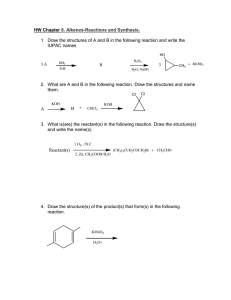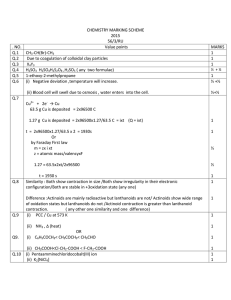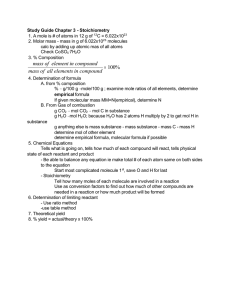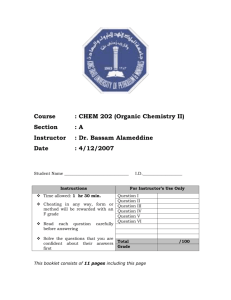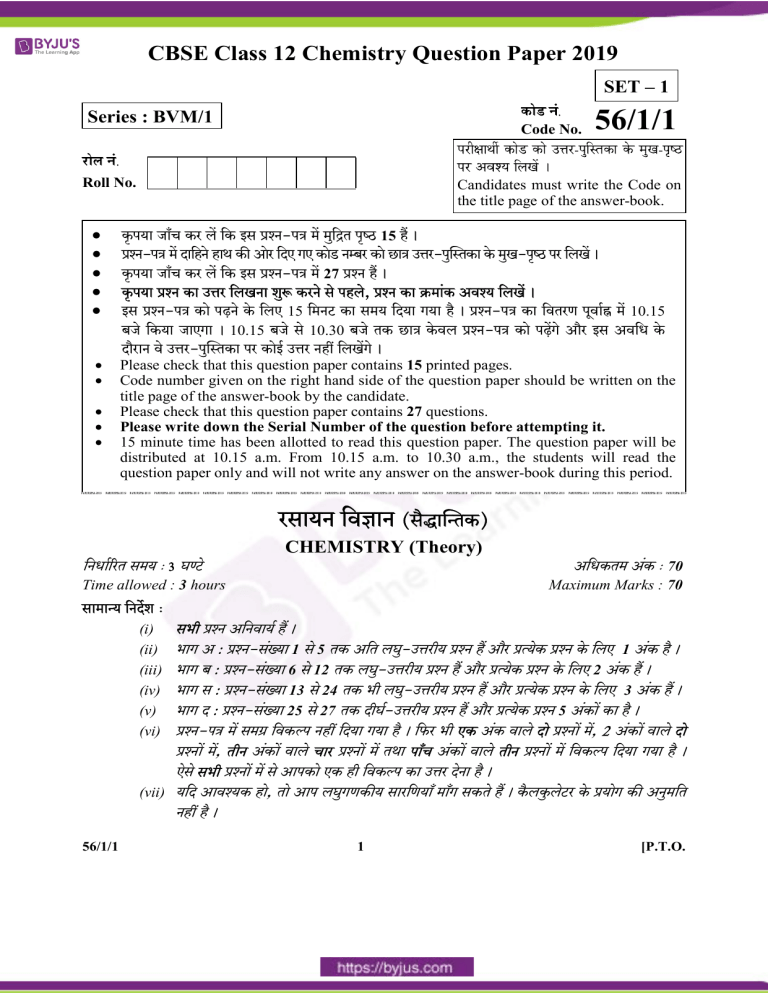
CBSE Class 12 Chemistry Question Paper 2019 SET – 1 Series : BVM/1 Code No. Roll No. 56/1/1 Candidates must write the Code on the title page of the answer-book. - 15 - - - - 27 , - 15 - 10.15 10.15 10.30 - - Please check that this question paper contains 15 printed pages. Code number given on the right hand side of the question paper should be written on the title page of the answer-book by the candidate. Please check that this question paper contains 27 questions. Please write down the Serial Number of the question before attempting it. 15 minute time has been allotted to read this question paper. The question paper will be distributed at 10.15 a.m. From 10.15 a.m. to 10.30 a.m., the students will read the question paper only and will not write any answer on the answer-book during this period. () CHEMISTRY (Theory) Time allowed : 3 hours (i) (ii) (iii) (iv) (v) (vi) (vii) 56/1/1 70 Maximum Marks : 70 : - 1 5 - 1 : - 6 12 - 2 : - 13 24 - 3 : - 25 27 - 5 - , 2 , , 1 [P.T.O. General Instructions : (i) All questions are compulsory. (ii) Section A : Q. no. 1 to 5 are very short-answer questions and carry 1 mark each. (iii) Section B : Q. no. 6 to 12 are short-answer questions and carry 2 marks each. (iv) Section C : Q. no. 13 to 24 are also short-answer questions and carry 3 marks each. (v) Section D : Q. no. 25 to 27 are long answer questions and carry 5 marks each. (vi) There is no overall choice. However, an internal choice has been provided in two questions of one mark, two questions of two marks, four questions of three marks and all the three questions of five marks weightage. You have to attempt only one of the choices in such questions. (vii) Use log tables if necessary. Use of calculators is not allowed. : SECTION : A 1. NaCl AgCl ? 1 Out of NaCl and AgCl, which one shows Frenkel defect and why ? 2. : 1 (CH3)3N, C2H5OH, C2H5NH2 Arrange the following in increasing order of boiling points : (CH3)3N, C2H5OH, C2H5NH2 3. ? () ? Why are medicines more effective in colloidal state ? OR What is difference between an emulsion and a gel ? 56/1/1 2 1 4. 1 Define ambidient nucleophile with an example. 5. ? 1 What is the basic structural difference between glucose and fructose ? OR Write the products obtained after hydrolysis of lactose. : SECTION : B 6. (i) XeF2 (ii) MnO2 HCl 2 : (i) H2O, H2S, H2Se, H2Te – (ii) HF, HCl, HBr, HI – Write balanced chemical equations for the following processes : (i) XeF2 undergoes hydrolysis. (ii) MnO2 is heated with conc. HCl. OR Arrange the following in order of property indicated for each set : 56/1/1 (i) H2O, H2S, H2Se, H2Te – increasing acidic character (ii) HF, HCl, HBr, HI – decreasing bond enthalpy 3 [P.T.O. 7. 2 State Raoult’s law for a solution containing volatile components. Write two characteristics of the solution which obeys Raoult’s law at all concentrations. 8. 2 I– 2H2O2 –––––––––––––– 2H2O + O2 : (1) H2O2 + I– H2O + IO– () (2) H2O2 + IO– H2O + I– + O2 () (ii) (iii) (1) (2) ? (i) For a reaction I– 2H2O2 –––––––––––––– 2H2O + O2 alkaline medium the proposed mechanism is as given below : (1) H2O2 + I– H2O + IO– (slow) (2) H2O2 + IO– H2O + I– + O2 (fast) (i) Write rate law for the reaction. (ii) Write the overall order of reaction. (iii) Out of steps (1) and (2), which one is rate determining step ? 9. MnO2 KOH KNO3 (A) (A) (B) (B) KI (C) (B) KI (D) (A), (B), (C) (D) When MnO2 is fused with KOH in the presence of KNO3 as an oxidizing agent, it gives a dark green compound (A). Compound (A) disproportionates in acidic solution to give purple compound (B). An alkaline solution of compound (B) oxidises KI to compound (C) whereas an acidified solution of compound (B) oxidises KI to (D). Identify (A), (B), (C), and (D). 56/1/1 4 2 10. [Pt(en)2Cl2] IUPAC IUPAC : (i) (III) (ii) (III) 2 Write IUPAC name of the complex [Pt(en)2Cl2]. Draw structures of geometrical isomers for this complex. OR Using IUPAC norms write the formulae for the following : (i) Hexaamminecobalt(III) sulphate (ii) Potassium trioxalatochromate(III) 11. [CoF6]3– [Co(en)3]3+ ? 2 (ii) (iii) (iv) (Co = 27) (i) Out of [CoF6]3– and [Co(en)3]3+, which one complex is (i) paramagnetic (ii) more stable (iii) inner orbital complex and (iv) high spin complex (Atomic no. of Co = 27) 12. 56/1/1 A B (i) KMnO4 – KOH H3O+ –––––––––––––––– A –––––––––––– B (ii) CrO3 H2N–NH–CONH2 –––––––––––––– A –––––––––––––––––– B 5 2 [P.T.O. Write structures of compounds A and B in each of the following reactions : (i) KMnO4 – KOH H3O+ –––––––––––––––– A –––––––––––– B (ii) CrO3 H2N–NH–CONH2 –––––––––––––– A –––––––––––––––––– B : SECTION : C 13. NH3 (k) 4 10–3 Ms–1 , NH3 0.1 M 0.064 M ? 3 The decomposition of NH3 on platinum surface is zero order reaction. If rate constant (k) is 4 10–3 Ms–1, how long will it take to reduce the initial concentration of NH3 from 0.1 M to 0.064 M. 14. (i) ? (ii) ? ? (iii) 56/1/1 ? 6 3 (i) What is the role of activated charcoal in gas mask ? (ii) A colloidal sol is prepared by the given method in figure. What is the charge on hydrated ferric oxide colloidal particles formed in the test tube ? How is the sol represented ? (iii) How does chemisorption vary with temperature ? 15. (fcc) 300 pm 10.8 g cm–3 108 g 3 An element crystallizes in fcc lattice with a cell edge of 300 pm. The density of the element is 10.8 g cm–3. Calculate the number of atoms in 108 g of the element. 16. (M = 342 g mol–1) 4% ( w/w) 271.15 K (M = 180 g mol–1) 5% 3 ( : = 273.15 K) A 4% solution(w/w) of sucrose (M = 342 g mol–1) in water has a freezing point of 271.15 K. Calculate the freezing point of 5% glucose (M = 180 g mol–1) in water. (Given : Freezing point of pure water = 273.15 K) 56/1/1 7 [P.T.O. 17. (i) (ii) (b) Cu2S (a) (a) (b) 18. 3 Name the method of refining which is (i) used to obtain semiconductor of high purity, (ii) used to obtain low boiling metal. Write chemical reactions taking place in the extraction of copper from Cu2S. 3 (ii) (Mn2+|Mn) E (Cu2+|Cu) (iii) (i) Give reasons for the following : (i) Transition elements and their compounds act as catalysts. (ii) E value for (Mn2+|Mn) is negative whereas for (Cu2+|Cu) is positive. (iii) Actinoids show irregularities in their electronic configuration. 19. -6,6 (ii) (iii) -S (i) 56/1/1 (i) CH3 | –[ CH2 –CH –] n ? (ii) : (iii) ? 8 3 Write the structures of monomers used for getting the following polymers : (i) Nylon-6,6 (ii) Glyptal (iii) Buna-S OR (i) CH3 | Is –[ CH2 –CH –] n a homopolymer or copolymer ? Give reason. (ii) Write the monomers of the following polymer : (iii) What is the role of Sulphur in vulcanization of rubber ? 20. ? (ii) ? (iii) ? : (i) - (ii) () (iii) (i) (i) What type of drug is used in sleeping pills ? (ii) What type of detergents are used in toothpastes ? 3 (iii) Why the use of alitame as artificial sweetener is not recommended ? OR Define the following terms with a suitable example in each : (i) Broad-spectrum antibiotics (ii) Disinfectants (iii) Cationic detergents 56/1/1 9 [P.T.O. 21. (i) (CH3)3C–Br (CH3)3C–I SN1 ? (ii) p- NaOH 443 K (iii) -2- ? (i) Out of (CH3)3C–Br and (CH3)3C–I, which one is more reactive towards SN1 and why ? (ii) Write the product formed when p-nitrochlorobenzene is heated with aqueous NaOH at 443 K followed by acidification. 3 (iii) Why dextro and laevo – rotatory isomers of Butan-2-ol are difficult to separate by fractional distillation ? 22. ‘A’, Br2 KOH C6H7N ‘B’ CHCl3 ‘C’ A, B C IUPAC 3 An aromatic compound ‘A’ on heating with Br2 and KOH forms a compound ‘B’ of molecular formula C6H7N which on reacting with CHCl3 and alcoholic KOH produces a foul smelling compound ‘C’. Write the structures and IUPAC names of compounds A, B and C. 23. (i) (ii) 3 NaCN/HCl –––––––––––––– (C6H5CH2)2Cd + 2CH3COCl –– CH3 | (i) Br2 / (iii) CH3– CH – COOH –––––––––––––––––––– (ii) H2O : (i) Ba(OH)2 (ii) Zn(Hg)/ HCl (iii) Pd/BaSO4 56/1/1 10 Complete the following reactions : (i) (ii) NaCN/HCl –––––––––––––– (C6H5CH2)2Cd + 2CH3COCl –– CH3 | (i) Br2 / Red P4 (iii) CH3– CH – COOH –––––––––––––– (ii) H2O OR Write chemical equations for the following reactions : (i) Propanone is treated with dilute Ba(OH)2. (ii) Acetophenone is treated with Zn(Hg)/Conc. HCl (iii) Benzoyl chloride is hydrogenated in presence of Pd/BaSO4. 24. : (i) (ii) (iii) D- : (i) (ii) (iii) 3 Differentiate between the following : (i) Amylose and Amylopectin (ii) Peptide linkage and Glycosidic linkage (iii) Fibrous proteins and Globular proteins OR Write chemical reactions to show that open structure of D-glucose contains the following : (i) Straight chain (ii) Five alcohol groups (iii) Aldehyde as carbonyl group 56/1/1 11 [P.T.O. : SECTION : D 25. E 2.71 V Mg(s) + Cu2+(0.01 M) ––– Mg2+(0.001 M) + Cu(s) E (i) 2.71 V (ii) 2.71 V (a) FeSO4 ZnSO4 - - X Y 2 - Fe 2.8 g X ? Y Zn ( : Fe = 56 g mol–1 Zn = 65.3 g mol–1), 1F = 96500 C mol–1) (b) (^m) (c1/2) - A B : : (i) - A B (ii) - A B ^m ? Ecell for the given redox reaction is 2.71 V Mg(s) + Cu2+(0.01 M) ––– Mg2+(0.001 M) + Cu(s) Calculate Ecell for the reaction. Write the direction of flow of current when an external opposite potential applied is (i) less than 2.71 V and (ii) greater than 2.71 V OR 56/1/1 12 5 (a) A steady current of 2 amperes was passed through two electrolytic cells X and Y connected in series containing electrolytes FeSO4 and ZnSO4 until 2.8 g of Fe deposited at the cathode of cell X. How long did the current flow ? Calculate the mass of Zn deposited at the cathode of cell Y. (Molar mass : Fe = 56 g mol–1 Zn = 65.3 g mol–1, 1F = 96500 C mol–1) (b) In the plot of molar conductivity (^m) vs square root of concentration (c1/2), following curves are obtained for two electrolytes A and B : Answer the following : (i) Predict the nature of electrolytes A and B. (ii) What happens on extrapolation of ^m to concentration approaching zero for electrolytes A and B ? 26. ? (i) (ii) -2- (b) : (a) 5 H2SO4 C2H5OH –––––––––––– CH2 = CH2 + H2O 443 K ? (a) : (i) p- o- - (ii) t-, t- 2- (b) : (i) - (ii) (c) (c) 56/1/1 13 [P.T.O. (a) (b) (c) (a) (b) (c) 27. 56/1/1 How do you convert the following : (i) Phenol to Anisole (ii) Ethanol to Propan-2-ol Write mechanism of the following reaction : H2SO4 C2H5OH –––––––––––– CH2 = CH2 + H2O 443 K Why phenol undergoes electrophilic substitution more easily than benzene ? OR Account for the following : (i) o-nitrophenol is more steam volatile than p-nitrophenol. (ii) t-butyl chloride on heating with sodium methoxide gives 2-methylpropene instead of t-butylmethylether. Write the reaction involved in the following : (i) Reimer-Tiemann reaction (ii) Friedal-Crafts Alkylation of Phenol Give simple chemical test to distinguish between Ethanol and Phenol. : (i) (ii) P-P N-N (iii) (b) Cu : (i) HNO3 (ii) HNO3 (a) (i) H3PO3 (ii) XeF4 (b) : (i) F2 (ii) 15 N2O3 Bi2O3 (c) (a) 14 5 (a) Give reasons for the following : (i) Sulphur in vapour state shows paramagnetic behaviour. (ii) N-N bond is weaker than P-P bond. (iii) Ozone is thermodynamically less stable than oxygen. (b) Write the name of gas released when Cu is added to (i) dilute HNO3 and (ii) conc. HNO3 OR (a) (b) (c) (i) Write the disproportionation reaction of H3PO3. (ii) Draw the structure of XeF4. Account for the following : (i) Although Fluorine has less negative electron gain enthalpy yet F2 is strong oxidizing agent. (ii) Acidic character decreases from N2O3 to Bi2O3 in group 15. Write a chemical reaction to test sulphur dioxide gas. Write chemical equation involved. ___________ 56/1/1 15 [P.T.O.
